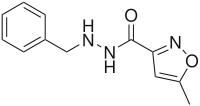Isocarboxazid
Isocarboxazid (Marplan, Marplon, Enerzer) is a non-selective, irreversible monoamine oxidase inhibitor (MAOI) of the hydrazine class used as an antidepressant.[1] Along with phenelzine and tranylcypromine, it is one of only three classical MAOIs still available for clinical use in the treatment of psychiatric disorders in the United States,[2][3] though it is not as commonly employed in comparison to the others.[2][3]
 | |
| Clinical data | |
|---|---|
| Trade names | Marplan |
| AHFS/Drugs.com | Consumer Drug Information |
| MedlinePlus | a605036 |
| Pregnancy category |
|
| Routes of administration | Oral |
| ATC code | |
| Legal status | |
| Legal status |
|
| Pharmacokinetic data | |
| Bioavailability | ? |
| Metabolism | Liver |
| Elimination half-life | ? |
| Excretion | Urine |
| Identifiers | |
IUPAC name
| |
| CAS Number | |
| PubChem CID | |
| IUPHAR/BPS | |
| DrugBank | |
| ChemSpider | |
| UNII | |
| KEGG | |
| ChEMBL | |
| CompTox Dashboard (EPA) | |
| ECHA InfoCard | 100.000.399 |
| Chemical and physical data | |
| Formula | C12H13N3O2 |
| Molar mass | 231.25 g/mol g·mol−1 |
| 3D model (JSmol) | |
SMILES
| |
InChI
| |
| | |
Isocarboxazid is primarily used to treat mood and anxiety disorders. It has also been investigated in the treatment of Parkinson's disease and other dementia-related disorders. Isocarboxazid, as well as other MAOIs, increase the levels of the monoamine neurotransmitters serotonin, dopamine, and norepinephrine in the brain.[4]
Classical MAOIs, including isocarboxazid, are used only very rarely due to prominent food and drug interactions and have been largely superseded by newer antidepressants such as the selective serotonin reuptake inhibitors (SSRIs). The cause of the interactions is because MAOIs inhibit the metabolism of dietary amines (e.g., tyramine) and the monoamine neurotransmitters. In combination with other drugs that increase the levels of the monoamine neurotransmitters such as the SSRIs, or with certain foods high in dietary amines such as aged cheeses, MAOIs can produce dangerous elevations of monoamine neurotransmitters resulting in potentially life-threatening syndromes such as hypertensive crisis and serotonin syndrome.
See also
References
- Fagervall I, Ross SB (April 1986). "Inhibition of monoamine oxidase in monoaminergic neurones in the rat brain by irreversible inhibitors". Biochemical pharmacology. 35 (8): 1381–7. doi:10.1016/0006-2952(86)90285-6. PMID 2870717.
- David Rosenberg (21 August 2013). Pocket Guide For The Textbook Of Pharmacotherapy For Child And Adolescent Psychiatric Disorders. Routledge. pp. 176–. ISBN 978-1-134-86002-9.
- Lawrence A. Labbate; Maurizio Fava; Jerrold F. Rosenbaum; George W. Arana (28 March 2012). Handbook of Psychiatric Drug Therapy. Lippincott Williams & Wilkins. pp. 99–. ISBN 978-1-4511-5307-1.
- Volz, Hanz-Peter. (November 1998) “Monoamine Oxidase Inhibitors A Perspective on Their Use in The Elderly” Biochemical Pharmacology (5) 341-352.